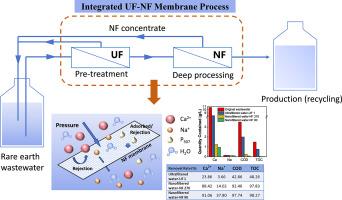Design and optimization of an integrated UF-NF membrane process for treating rare earth refining wastewater
IF 6.3
2区 工程技术
Q1 ENGINEERING, CHEMICAL
引用次数: 0
Abstract
As the rare earth industry develops and energy efficiency improves, high-salinity rare earth smelting wastewater poses a significant environmental concern. This study applied integrated ultrafiltration (UF) - nanofiltration (NF) membrane technology to treat high-salt rare earth smelting wastewater (Ca2⁺: 10.75 g/L, COD: 3.5 g/L, turbidity: 1.36 NTU) for salt removal and recovery. The effects of UF pretreatment were explored, and the operating parameters for NF were optimized, with the performance of various commercial NF membranes being evaluated. Membrane fouling conditions were also investigated to determine appropriate cleaning methods. The experimental results demonstrate that the UF-NF integrated process is effective in actual wastewater treatment. The calcium ion content in the permeate was reduced from 10.75 g/L in the feed solution to 0.96 g/L, achieving a removal rate of 91.1 %, which meets reuse water standards. Trace amounts of organic molecules in the water, such as 2-Ethylhexyl phosphonic acid mono-2-ethylhexyl ester (P507), were also effectively removed. The removal rates for COD and TOC were notably high at 97.7 % and 98.3 %, respectively. Acid washing, alkaline washing, and water washing were employed to clean the membranes, all of which achieved flux recovery rates exceeding 95.0 %. In summary, the integrated UF-NF process demonstrated outstanding performance in salt recovery/separation of different valence salts from rare earth smelting wastewater. Its excellent operational stability and high flux recovery rates highlight its strong industrial applicability. The exceptional treatment efficacy it displays provides a feasible technological pathway for resource recovery and water recycling in practical applications.

设计和优化处理稀土提炼废水的 UF-NF 一体化膜工艺
随着稀土工业的发展和能源效率的提高,高盐稀土冶炼废水已成为一个重要的环境问题。本研究采用集成超滤(UF)-纳滤(NF)膜技术处理高盐稀土冶炼废水(Ca2⁺:10.75 g/L,COD:3.5 g/L,浊度:1.36 NTU),以实现除盐和回收。探索了超滤预处理的效果,优化了纳滤的操作参数,并对各种商用纳滤膜的性能进行了评估。此外,还对膜堵塞条件进行了调查,以确定适当的清洁方法。实验结果表明,超滤-纳滤一体化工艺在实际废水处理中是有效的。渗透液中的钙离子含量从进料溶液中的 10.75 克/升降至 0.96 克/升,去除率达到 91.1%,符合回用水标准。水中的微量有机分子,如 2-乙基己基膦酸单-2-乙基己酯(P507)也被有效去除。COD 和 TOC 的去除率分别高达 97.7% 和 98.3%。清洗膜时采用了酸洗、碱洗和水洗,其通量回收率均超过 95.0%。总之,UF-NF 集成工艺在稀土冶炼废水中不同价盐的盐回收/分离方面表现出色。其出色的运行稳定性和高通量回收率凸显了其强大的工业适用性。其卓越的处理效果为实际应用中的资源回收和水循环提供了一条可行的技术途径。
本文章由计算机程序翻译,如有差异,请以英文原文为准。
求助全文
约1分钟内获得全文
求助全文
来源期刊

Journal of water process engineering
Biochemistry, Genetics and Molecular Biology-Biotechnology
CiteScore
10.70
自引率
8.60%
发文量
846
审稿时长
24 days
期刊介绍:
The Journal of Water Process Engineering aims to publish refereed, high-quality research papers with significant novelty and impact in all areas of the engineering of water and wastewater processing . Papers on advanced and novel treatment processes and technologies are particularly welcome. The Journal considers papers in areas such as nanotechnology and biotechnology applications in water, novel oxidation and separation processes, membrane processes (except those for desalination) , catalytic processes for the removal of water contaminants, sustainable processes, water reuse and recycling, water use and wastewater minimization, integrated/hybrid technology, process modeling of water treatment and novel treatment processes. Submissions on the subject of adsorbents, including standard measurements of adsorption kinetics and equilibrium will only be considered if there is a genuine case for novelty and contribution, for example highly novel, sustainable adsorbents and their use: papers on activated carbon-type materials derived from natural matter, or surfactant-modified clays and related minerals, would not fulfil this criterion. The Journal particularly welcomes contributions involving environmentally, economically and socially sustainable technology for water treatment, including those which are energy-efficient, with minimal or no chemical consumption, and capable of water recycling and reuse that minimizes the direct disposal of wastewater to the aquatic environment. Papers that describe novel ideas for solving issues related to water quality and availability are also welcome, as are those that show the transfer of techniques from other disciplines. The Journal will consider papers dealing with processes for various water matrices including drinking water (except desalination), domestic, urban and industrial wastewaters, in addition to their residues. It is expected that the journal will be of particular relevance to chemical and process engineers working in the field. The Journal welcomes Full Text papers, Short Communications, State-of-the-Art Reviews and Letters to Editors and Case Studies
 求助内容:
求助内容: 应助结果提醒方式:
应助结果提醒方式:


